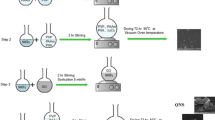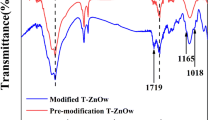Abstract
The pechini method was used to synthesize antimony-doped tin oxide (ATO) nanoparticles, and the subsequent solution co-blend was employed to fabricate ATO/PVB nanocomposites. Uv-Vis-NIR spectra show that the addition of ATO nano particles can significantly enhance the thermal insulating efficiency of ATO/PVB nanocomposites. With the increase of ATO content, the thermal insulating efficiency is increased. Uv is almost fully absorbed by all ATO/PVB nanocomposites. Vis transmittance-haze spectra reveal that ATO/PVB nanocomposites exhibit higher Vis transmittance of over 72.7% and lower haze of below 2% when ATO content is in the range of 0.1 wt%–0.5 wt%. The thermal insulating tests indicate that in comparison with the pure PVB film, nanocomposite films with 0.1 wt%–0.5 wt% ATO can reduce temperature of 1–3 °C, suggesting that this novel nanocomposite can be used for energy-saving glass.
Similar content being viewed by others
References
Koji N, Takashi O, Nobuo O. Properties of Poly (vinyl butyral) / TiO2 Nanocomposites Formed by Sol-gel Process [J]. Compos. Part B-Eng., 2004, 35: 2 19–22
Feng L, Cheng C, Yao BD, et al. Photoluminescence Study of Single ZnO Nanostructures: Size Effect[J]. Appl. Phys. Lett., 2009, 95: 053–057
Chao LC, Yang SH. Growth and Auger Electron Spectroscopy Characterization of Donut-shaped ZnO Nanostructures[J]. Appl. Surf. Sci., 2007, 253: 7 162–7 165
Shokr E K, Wakkad M M, El-Ghanny H A A, et al. Sb-doping Effects on Optical and Electrical Parameters of SnO2 Films[J]. J. Phys. Chem. Solids, 2000, 61: 75–85
Elangovan E, Ramamurthi K. Studies on Optical Properties of Polyerystalline SnO2: Sb Thin Films Prepared Using SnCl2 Precursor[J]. Cryst. Res. Technol., 2003, 38: 779–784
Alma MJ, Cameron DC. Characterization of Transparent Conductive ITO Thin Films Deposited on Titanium Dioxide Film by a Sol-gel Process[J]. Surf. Coat. Technol., 2001, 142–144: 776–780
He QX, Tu WP, Hu JQ. Synthesis and Characterization of Bismuthdoped Tin Dioxide Nanometer Powders[J]. J. Cent. South Univ. Technol., 2006, 13: 519–524
Cai L. High Quality Al-doped ZnO Thin Films by Chemical Coprecipitation[J]. Phys. Status Solidi A, 2009, 206: 1 461–1 464
Rockemberger J, Felde U, Tischer M. Near Edge X-ray Absorption Fine Structure Measurements (XANES) and Extended X-ray Absorption Fine Structure Measurements(EXAFS) of the Valence State and Coordination of Antimony in Doped Nanocrystallline SnO2[J]. J. Appl. Phys., 2000, 112: 4 296–4 304
Terrier C, Chatelon J P, Roger J A. Electrical and Optical Properties of Sb: SnO2 Thin Films Obtained by the Sol-gel Method[J]. Thin Solid Films, 1997, 295: 95–100
Jayakumar OD, Sudarsan V, Kulshreshtha SK. Metallic Nature of Snl−x SbxO2±δ(x=0.0, 0.10 and 0.20) Mixed Oxides: Probed by 119Sn MAS NMR[J]. Physica B, 2007, 392: 67–71
Zhang J R, Gao L. Synthesis and Characterization of Antimony-doped Tin Oxide (ATO) Nanoparticles by a New Hydrothermal Method[J]. Mater. Chem. Phys., 2004, 87: l0–13
Terrier C, Chatelon J P, Roger J A. Analysis of Antimony Doping in Tin Oxide Thin Films Obtained by the Sol-gel Method[J]. J. Sol-gel Sci. Technol., 1997, 10: 75–81
Orel B, Lavrenčič-Štankgar U, Crnjak-Orel Z, et al. Structural and FTIR Spectroscopic Studies of Gel-xerogel-oxide Transitions of SnO2 and SnO2: Sb Powders and Dip-coated Films Prepared Via Inorganic Sol-gel Route[J]. J. Non-Cryst. Solids, 1994, 167: 272–288
Mauro E, Marco A, Luciana M, et al. Sol-Gel Processing and Characterization of Pure and Metal-doped SnO2 Thin Films[J]. J. Am. Ceram. Soc., 2001, 84: 48–54
Seo M, Akutsu Y, Kagemoto H. Preparation and Properties of Sbdoped SnO2/metal Substrates by Sol-gel and Dip Coating[J]. Ceram. Int., 2007, 33: 625–629
Elangovan E, Ramamurthi K. A Study on Low Cost-high Conducting Fluorine and Antimony-doped Tin Oxide Thin Films[J]. Appl. Surf. Sci., 2005, 249: 183–196
Lee S, Park B. Structural, Electrical and Optical Characteristics of SnO2: Sb Thin Films by Ultrasonic Spray Pyrolysis[J]. Thin Solid Films, 2006, 510: 154–158
Bernardi MIB, Cava S, Santos COP, et al. Comparison of Blue Pigments Prepared by Two Different Methods[J]. J. Eur. Ceram. Soc., 2002, 22: 2 911–2 915
Pechini M P. Method of Preparing Lead and Alkaline Earth Titanates and Niobates and Coating Method Using the Same to Form a Capacitor[P]. U.S. Patent No. 3330697, July 11, 1967
Posthumus W, Magusin PC, Brokken-Zijp JC, et al. Surface Modification of Oxide Nanoparticles Using 3-methacryloxypropyltrim Ethoxysilane[J]. J. Colloid Interface Sci., 2004, 269: 109–116
Standards Press of China. Safety Glazing Materials for Road Vehicles[S]. GB 9656-2003, 2003
Author information
Authors and Affiliations
Corresponding author
Additional information
Funded by Wuhan Science and Technology Bureau, Hubei, China (No. 200911011428), Hubei Science and Technology Department, China (No. 2010EGA047) and Key Laboratory of Green Preparation and Application for Functional Materials, Ministry of Education, China (No. 2010EKLGPAFM018)
Rights and permissions
About this article
Cite this article
Zhang, G., Yan, W. & Jiang, T. Fabrication and thermal insulating properties of ATO/PVB nanocomposites for energy saving glass. J. Wuhan Univ. Technol.-Mat. Sci. Edit. 28, 912–915 (2013). https://doi.org/10.1007/s11595-013-0792-4
Received:
Accepted:
Published:
Issue Date:
DOI: https://doi.org/10.1007/s11595-013-0792-4




